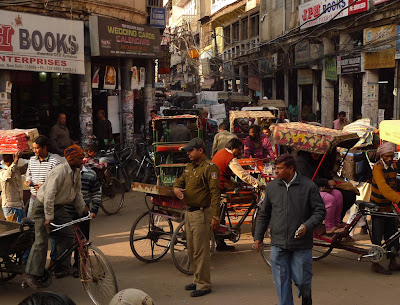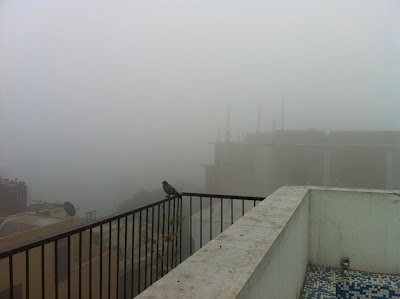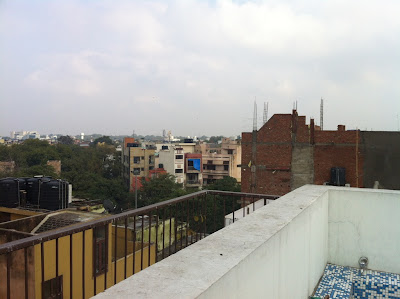Always agree to a final price before you take a seat on a rickshaw.
Rickshaw rides should be cheap but six months ago my Western mind was not prepared to accept how cheap a rickshaw ride could actually be. My benchmark for hired private transportation is a NYC taxi cab where the meter spins faster than a winning Las Vegas slot machine - with all the winnings going to the driver.
Chandni Chowk rickshaw pullers surely never experience the feeling of a winning slot machine. There are thousands of pullers throughout Chandni Chowk and at any given time at least half are without passengers. The riderless rickshaws sit side-by-side in popular pickup spots like the entrances to the Metro station, or tourists sites like the Red Fort and Jama Masjid mosque. A savvy pedestrian can play one starving and waiting puller off another and another and another bargaining a 40 rupee ride down to 35, 30, 25, 20, even down to 15. Recently I bargained from 100 rupees down to 20. I felt like a cruel overlord when he finally delivered me to my location after more than a half hour pulling through choking traffic, dust and exhaust. I tipped him 10 rupees extra and he was smiling and happy for my generosity but I still felt like a shit. The man gave me a tough half hour of his life for 55 cents.
The first time I visited Chandni Chowk I had yet to learn how to suppress my native Midwestern penchant for agreeableness over hard-nose negotiation. Intellectually I was aware that the pullers would offer me prices higher than they would to a local but I didn't know if I should bargain for 25% or 50% or more off the asking price. Actually, I wasn't even aware that I should fix a firm price before accepting the ride. This came about when one of the pullers convinced me to take a ride to the Red Fort for 50 rupees (about one dollar) and then he would guide me to other sites around Chandni Chowk if I agreed. 50 rupees seemed a fair deal and I assumed he would find another passenger after I spent two hours roaming inside the Red Fort but when I exited, to my surprise, he was waving, smiling and ready to assist me on my continuing tour. I was vaguely uncomfortable but he assured me at this point that I could "pay what I wanted" when the tour was done.
Rickshaw rides should be cheap but six months ago my Western mind was not prepared to accept how cheap a rickshaw ride could actually be. My benchmark for hired private transportation is a NYC taxi cab where the meter spins faster than a winning Las Vegas slot machine - with all the winnings going to the driver.
Chandni Chowk rickshaw pullers surely never experience the feeling of a winning slot machine. There are thousands of pullers throughout Chandni Chowk and at any given time at least half are without passengers. The riderless rickshaws sit side-by-side in popular pickup spots like the entrances to the Metro station, or tourists sites like the Red Fort and Jama Masjid mosque. A savvy pedestrian can play one starving and waiting puller off another and another and another bargaining a 40 rupee ride down to 35, 30, 25, 20, even down to 15. Recently I bargained from 100 rupees down to 20. I felt like a cruel overlord when he finally delivered me to my location after more than a half hour pulling through choking traffic, dust and exhaust. I tipped him 10 rupees extra and he was smiling and happy for my generosity but I still felt like a shit. The man gave me a tough half hour of his life for 55 cents.
The first time I visited Chandni Chowk I had yet to learn how to suppress my native Midwestern penchant for agreeableness over hard-nose negotiation. Intellectually I was aware that the pullers would offer me prices higher than they would to a local but I didn't know if I should bargain for 25% or 50% or more off the asking price. Actually, I wasn't even aware that I should fix a firm price before accepting the ride. This came about when one of the pullers convinced me to take a ride to the Red Fort for 50 rupees (about one dollar) and then he would guide me to other sites around Chandni Chowk if I agreed. 50 rupees seemed a fair deal and I assumed he would find another passenger after I spent two hours roaming inside the Red Fort but when I exited, to my surprise, he was waving, smiling and ready to assist me on my continuing tour. I was vaguely uncomfortable but he assured me at this point that I could "pay what I wanted" when the tour was done.
From the Red Fort he pedaled me to Jama Masjid, the largest mosque in India and he waited 45 minutes while I toured. By now I was lost, I knew I wouldn't find my way back to the Metro without his assistance so I easily gave into his suggestion that we visit the Jain Temple. I thought he meant the large temple described in the guide books situated on the main intersection in Chandni Chowk but instead we turned into an alleyway, then another turn and a more narrow alley and so on until finally he stopped at an old wooden door, more like a gate. He pointed for me to go through the door - it was a passage into another alley. I stepped through and it was a bit like stepping through a portal or a wrinkle in time. This little alley was clean and the houses were well kept and brightly painted. I imagined that all of Chandni Chowk must have looked this way during the Mughal era. At the very end of the alley was the entrance to a tiny Jain temple no larger than a house. I was greeted at the door by the most gentle and sincere priest who told me to remove my shoes, leather accessories and wash my hands and mouth. After this purification I was allowed inside for a guided tour of this beautiful gem. Because of the maze and mystery of finding the place I felt I was seeing something few others had. I was happy when I walked back along that clean alley and through the door and to the other side, back into the dust and dilapidation of Chandni Chowk.
My rickshaw was waiting and my puller had another surprise for me. Again through turns and passageways we emerged onto a main road that was also the location of the well known spice market. More than a hundred stores stocked with open piles of any type of spice you could imagine. I was feeling like Marco Polo or some old European trader on the silk road. The late afternoon atmosphere had the sultry and dreamy ochre haze that India is well known for. The day was winding down and my friendly rickshaw puller took me to my final destination, a famous sweets shop next to the Metro station.
The fun ended. It was time to complete the deal that hadn't been negotiated at the start. Throughout the afternoon I was keeping a mental summation of the final bill based on the initial quote of 50 rupees for that lift to the Red Fort. Given the distances between sites and adding extra for the time he spent waiting I estimated a generous sum of 400 rupees but before I could offer my payment I watched words come from his mouth that said, almost in slow motion, "one thousand rupees."
Jackpot! Rickshaw puller wins at the slot machines!
The fun ended. It was time to complete the deal that hadn't been negotiated at the start. Throughout the afternoon I was keeping a mental summation of the final bill based on the initial quote of 50 rupees for that lift to the Red Fort. Given the distances between sites and adding extra for the time he spent waiting I estimated a generous sum of 400 rupees but before I could offer my payment I watched words come from his mouth that said, almost in slow motion, "one thousand rupees."
Jackpot! Rickshaw puller wins at the slot machines!
He was no longer the friendly and generous rickshaw puller I had known the whole afternoon. Now he was stern and his words were specific and grim. We argued, I said something about "paying what I want" and he described the long day, the hard work pedaling and that he was hungry. I felt like I was being cheated but we settled on 800 rupees, still a jackpot for him. I took the Metro home, had a hot shower and slept in a bed. That night he probably slept outside on his rickshaw seat.
 |
| The Beautiful Jain Temple was at the end of this alley in Chandni Chowk. |
 |
| Rickshaws wait for riders at a Metro station. Choose your pedaler! |

.jpg)

